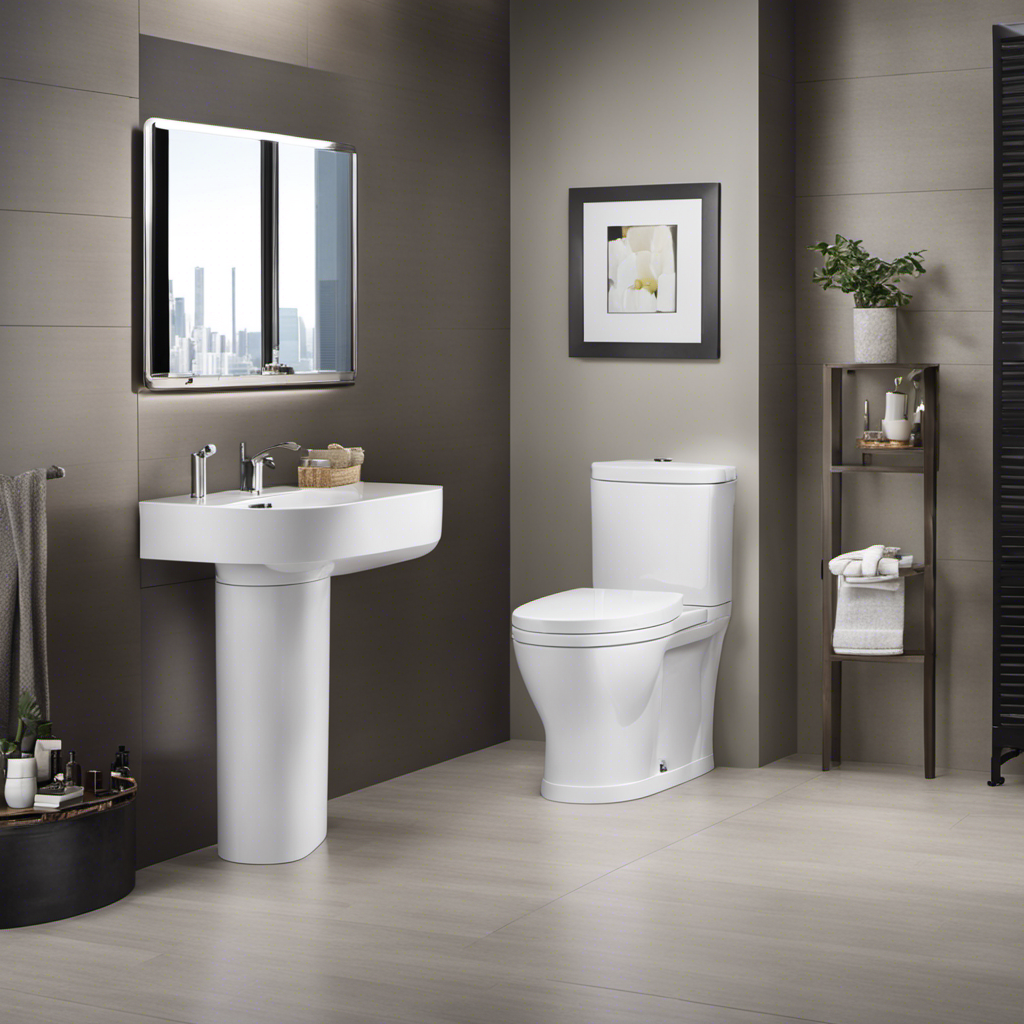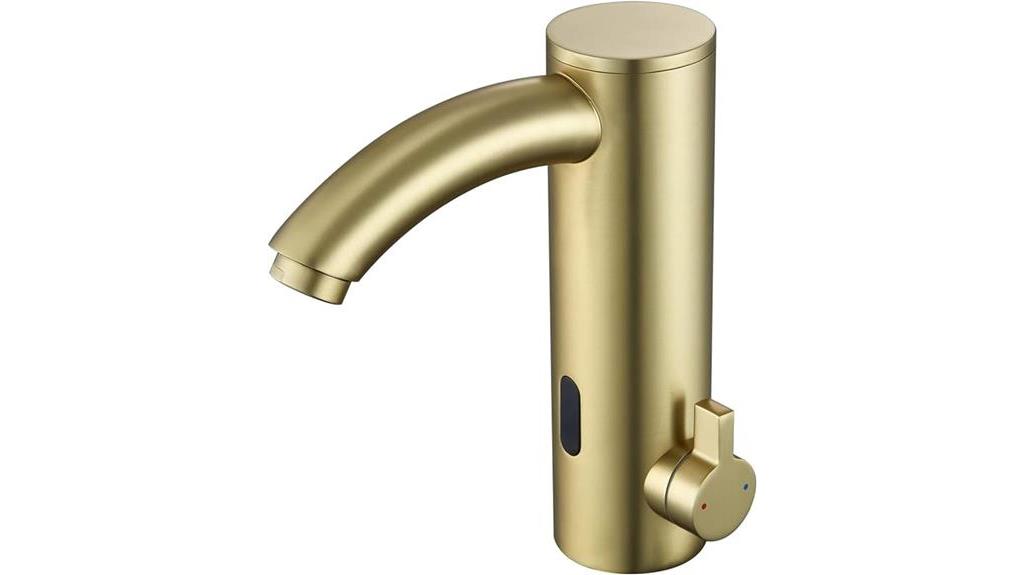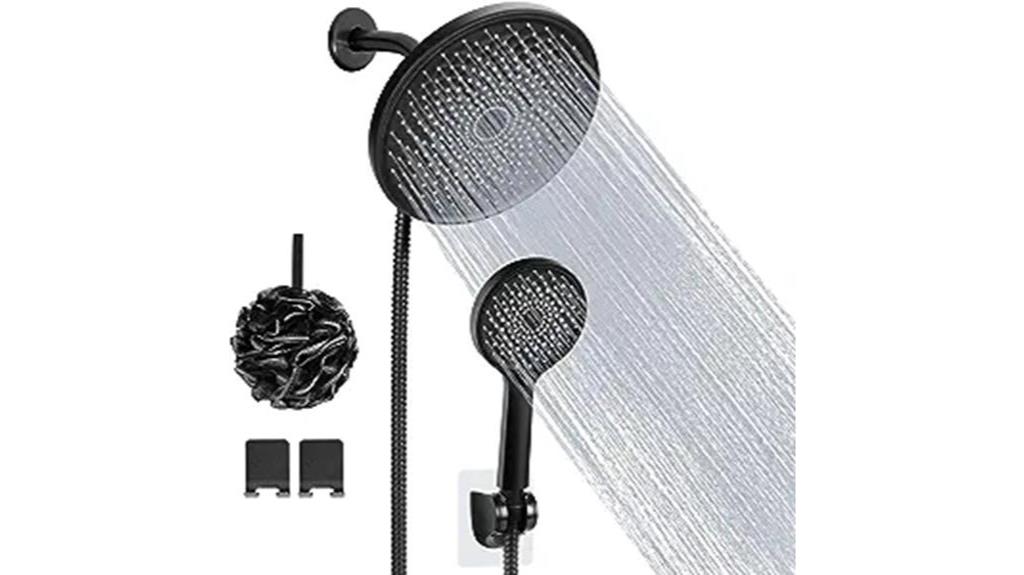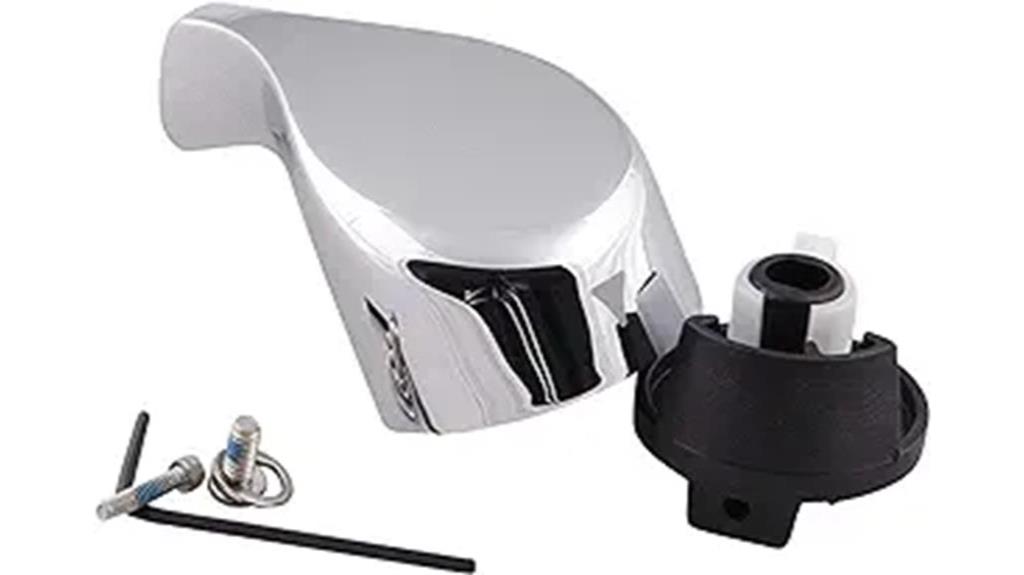Looking for the perfect pressure-assist toilet? Look no further!
In this article, I’ll guide you through the pros, cons, and installation tips of these efficient and powerful toilets.
With a small pressurized tank inside the tank, pressure-assist toilets deliver a forceful flush that prevents clogs and keeps your bowl clean.
They’re great for basements or areas with low water pressure.
So, let’s dive into the world of pressure-assist toilets and find the perfect one for you!
Key Takeaways
- Pressure-assist toilets provide extra power and efficiency, reducing chances of clogging and keeping toilet bowls cleaner.
- They can save money on water bills due to their higher flushing efficiency.
- Pressure-assist toilets are suitable for homes with low water pressure or basement bathrooms.
- When installing a pressure-assist toilet, consider the rough-in size, check what is included in the box, and seek professional help if needed.
The Benefits of Pressure-Assist Toilets
I really appreciate the benefits of pressure-assist toilets. One advantage is their extra power and efficiency in flushing, reducing the chances of clogging and keeping the toilet bowl cleaner.
Pressure-assist toilets have a small pressurized tank inside the toilet tank. This tank releases pressurized air when flushed, resulting in a more powerful flush. This increased power and efficiency make pressure-assist toilets advantageous over standard gravity-flow toilets.
They are more efficient at removing waste and reducing the chances of clogging due to the higher flow rate into the bowl. Additionally, pressure-assist toilets can save money on water bills due to their higher flushing efficiency.
These toilets are especially suitable for homes with low water pressure or basement bathrooms. Overall, the advantages of pressure-assist toilets lie in their enhanced flushing power and efficiency.
Drawbacks of Pressure-Assist Toilets
One drawback of pressure-assist toilets is that they tend to be louder during flushing compared to standard toilets. This is due to the pressurized air being released, providing a more powerful flush.
However, despite this drawback, pressure-assist toilets offer several advantages that make them worth considering.
Advantages of Pressure-Assist Toilets:
-
Extra power and efficiency: The pressure-assisted flushing system provides a stronger and more efficient flush, reducing the chances of clogging and keeping the toilet bowl cleaner.
-
Water bill savings: Pressure-assist toilets are more efficient at removing waste, which can save you money on water bills.
-
Dealing with condensation: These toilets are better at handling condensation compared to standard toilets.
-
Suitable for low water pressure: Pressure-assist toilets are a great option for homes with low water pressure or basement bathrooms.
When it comes to repair considerations, it’s important to note that repairing pressure-assist toilets may be more difficult and costly. Additionally, the availability of parts locally may be limited, leading to longer repair times.
It’s also worth mentioning that pressure-assist toilets lack dual-flush options, which may be a drawback for some individuals.
Despite these repair considerations, pressure-assist toilets offer numerous advantages that make them a viable option for many homeowners.
Factors to Consider When Choosing a Pressure-Assist Toilet
Considering the specific features, advantages, and price difference between pressure-assist toilets and regular toilets is essential when selecting the right option for your bathroom.
There are several factors to consider when choosing a pressure-assist toilet. First, understand the differences between pressure-assist toilets and standard gravity-flow toilets. Pressure-assist toilets have a small pressurized tank inside the toilet tank, providing a more powerful flush and reducing chances of clogging. They are more efficient at removing waste and have a higher flow rate into the bowl, resulting in cleaner toilet bowls.
Second, research and compare different brands and models of pressure-assist toilets. Read reviews and ratings from other homeowners to make an informed decision.
Lastly, take into account the price difference between pressure-assist toilets and regular toilets. While pressure-assist toilets may be more expensive, they can save money on water bills due to higher flushing efficiency. When installing a pressure-assist toilet, consider the rough-in size and what is included in the box, such as toilet bowl bolts and wax ring. Professional help is recommended for those who are not experienced in plumbing.
Understanding the Installation Process
The installation process for a pressure-assist toilet is similar to that of a standard gravity-flow toilet. Here are some steps to guide you through the installation:
- Start by shutting off the water supply to the toilet and draining the tank completely.
- Remove the old toilet by disconnecting the water supply line and unscrewing the bolts securing the toilet to the floor.
- Place a new wax ring onto the flange and position the new pressure-assist toilet over it.
- Secure the toilet to the floor by tightening the bolts and reconnect the water supply line.
- Turn on the water supply and allow the tank to fill.
- Test the flush to ensure proper functionality.
Common issues with pressure-assist toilets include:
- Noise during flushing: Due to the pressurized air release, pressure-assist toilets can be louder than standard toilets.
- Repair difficulties: Finding replacement parts for pressure-assist toilets may be more challenging and costly.
- Longer repair times: Limited availability of parts locally can lead to longer repair times.
Overall, pressure-assist toilets offer powerful flushing and efficiency, but it’s important to consider these common issues during installation and maintenance.
Comparing Pressure-Assist Toilets Vs. Standard Gravity-Flow Toilets
I find that comparing pressure-assist toilets to standard gravity-flow toilets helps me understand the differences in flushing power and efficiency. Pressure-assist toilets utilize a small pressurized tank inside the toilet tank, which releases pressurized air when flushed, resulting in a more powerful flush. On the other hand, traditional toilets rely on gravity to remove waste. To further illustrate the advantages of pressure-assist toilets, let’s compare them to traditional toilets in a table:
| Pressure-Assist Toilets | Traditional Toilets |
|---|---|
| More powerful flush | Relies on gravity |
| Reduces chances of clogging | Higher chance of clogging |
| Cleaner toilet bowls | Less effective at cleaning |
| Suitable for low water pressure | Not ideal for low water pressure |
As you can see, pressure-assist toilets offer a more efficient and powerful flushing experience, reducing the chances of clogging and keeping the toilet bowl cleaner. They are also suitable for homes with low water pressure. However, it is important to note that pressure-assist toilets tend to be more expensive and may be louder during flushing compared to traditional toilets. Overall, the advantages of pressure-assist toilets make them a worthwhile investment for improved flushing performance.
Top Pressure-Assist Toilet Brands and Models
When researching top pressure-assist toilet brands and models, I found that KOHLER, American Standard, and other reputable manufacturers offer a wide range of options to suit different preferences and needs.
Some of the top pressure-assist toilet models include the KOHLER Highline Classic Pressure Lite Toilet, featuring a 1.4 GPF and a DryLock installation system.
Another option is the KOHLER Karing 2.0 Intelligent Toilet, which is fully automated and includes a heated seat and highly adjustable bidet.
American Standard also offers excellent options, such as the Cadet Pressure-Assisted Toilet with an elongated bowl and a top-tier MaP score.
The Yorkville Two-Piece Toilet from American Standard is efficient at 1.1 GPF and comes with an excellent warranty.
These top pressure-assist toilet models provide the advantages of a more powerful flush, reduced chances of clogging, and cleaner toilet bowls.
Exploring Different Pressure-Assist Toilet Features
Exploring different features of pressure-assist toilets, it’s important to consider factors such as flush power, water efficiency, bowl shape, and seat height. Pressure-assist toilet technology utilizes a small pressurized tank to deliver a more powerful flush, reducing the chances of clogging and keeping the toilet bowl cleaner. When determining the right pressure-assist toilet size, it’s crucial to take into account the rough-in size, typically 12 inches, to ensure compatibility with your waste system. Additionally, considering the height and comfort of the toilet is essential. Standard height toilets are suitable for shorter individuals, while chair height toilets, with elongated bowls, offer added comfort for taller individuals and those with mobility issues. To help visualize the different features and advantages of pressure-assist toilets, here is a table:
| Feature | Advantage |
|---|---|
| Flush Power | More powerful flush, reduces clogging |
| Water Efficiency | Saves water, higher flushing efficiency |
| Bowl Shape | Elongated bowls provide additional comfort and space |
| Seat Height | Standard height for shorter individuals, chair height for taller individuals and those with mobility issues |
The Importance of Toilet Height and Comfort
Considering the height and comfort of a pressure-assist toilet is crucial when selecting the right option for your bathroom. The design of the toilet plays a significant role in determining the overall comfort level. Here are some key factors to consider:
-
Toilet height: There are two categories of toilet height – standard and chair height. Standard height toilets are suitable for shorter individuals, while chair height toilets, which are taller, provide added comfort and are ideal for taller individuals or those with mobility issues.
-
Elongated toilet bowls: Elongated bowls offer additional comfort and space in the front. They provide a more ergonomic seating position and are especially beneficial for individuals who require extra support.
When it comes to water efficiency, pressure-assist toilets are a great option. They use pressurized air to create a powerful flush, resulting in efficient water usage. This not only saves water but also reduces the chances of clogging. Additionally, pressure-assist toilets are suitable for homes with low water pressure or basement bathrooms.
Tips for Saving Money With a Pressure-Assist Toilet
When it comes to pressure-assist toilets, there are several tips to keep in mind for saving money and maximizing efficiency.
One of the key factors is proper toilet maintenance. Regular cleaning and checking for leaks can ensure that your toilet is functioning optimally.
Additionally, pressure-assist toilets often come with water-saving features, such as dual-flush options or low flow rates. These features can help reduce water consumption and ultimately save you money on your water bills.
It’s also important to consider the overall water efficiency of the toilet you choose. Look for models with high MaP scores and certifications from organizations like WaterSense.
Troubleshooting and Maintaining Your Pressure-Assist Toilet
I can troubleshoot and maintain my pressure-assist toilet by regularly checking for leaks and ensuring proper cleaning. Here are some troubleshooting tips and maintenance techniques to keep your pressure-assist toilet in top shape:
-
Troubleshooting Tips:
-
If the toilet doesn’t flush properly, check the pressure tank for any leaks or cracks.
-
Ensure that the water supply is turned on and the pressure-assist mechanism is functioning correctly.
-
If there is a weak flush, inspect the flush valve and flush handle for any obstructions or damage.
-
Maintenance Techniques:
-
Clean the pressure-assist toilet regularly to prevent the buildup of mineral deposits and bacteria.
-
Use a non-abrasive cleaner and a soft cloth to clean the toilet bowl and exterior surfaces.
-
Check the water level in the tank and adjust it if necessary to ensure proper flushing.
Frequently Asked Questions
Are Pressure-Assist Toilets More Difficult to Repair and Maintain Compared to Standard Gravity-Flow Toilets?
Pressure-assist toilets can pose difficulties in repair and maintenance compared to standard gravity-flow toilets. Repairing them may be more costly and complicated, with limited availability of parts locally, leading to longer repair times.
Can Pressure-Assist Toilets Be Installed in Basement Bathrooms or Homes With Low Water Pressure?
Sure, pressure-assist toilets can be installed in basement bathrooms or homes with low water pressure. They provide more power and efficiency compared to gravity-flow toilets, saving water and reducing clogs.
Is It Possible to Find Pressure-Assist Toilets With Dual-Flush Options?
Yes, it is possible to find pressure-assist toilets with dual-flush options. Dual-flush technology allows for different water volumes to be used for liquid waste and solid waste, resulting in water conservation and increased efficiency.
What Is the Difference in Price Between Pressure-Assist Toilets and Regular Toilets?
The price difference between pressure-assist toilets and regular toilets varies depending on the brand and model. However, pressure-assist toilets generally cost more due to their advanced flushing system and higher performance evaluation.
Are Pressure-Assist Toilets Suitable for Households With Taller Individuals or People With Mobility Issues?
Yes, pressure-assist toilets are suitable for households with taller individuals or people with mobility issues. The chair height and elongated bowl provide additional comfort and space, making it easier to use for those with specific needs.
Conclusion
In conclusion, choosing the perfect pressure-assist toilet requires careful consideration of various factors.
While these toilets offer numerous benefits such as powerful flushing and reduced chances of clogging, they also have drawbacks like higher cost and noise during flushing.
When selecting a pressure-assist toilet, it is essential to understand the installation process, compare it with standard gravity-flow toilets, and explore different features.
Additionally, considering toilet height and comfort options is crucial.
By following these tips and maintaining the toilet properly, homeowners can enjoy the efficiency and savings that come with a pressure-assist toilet.










